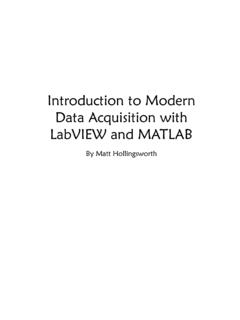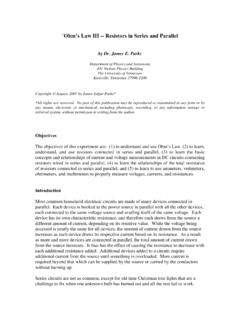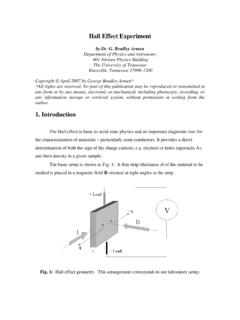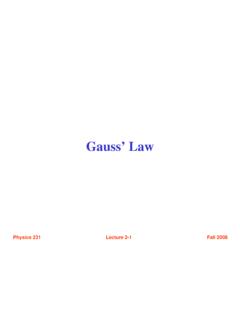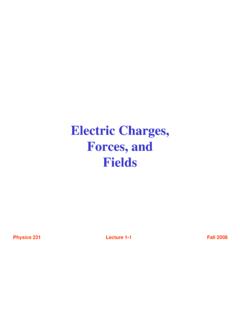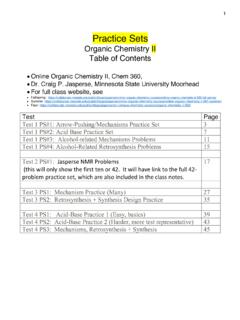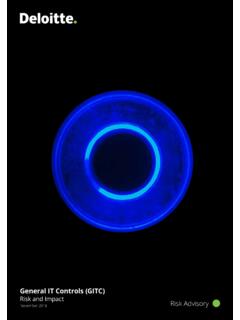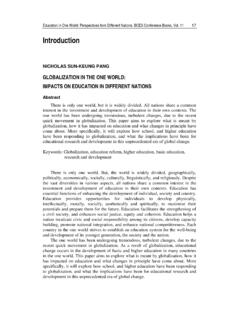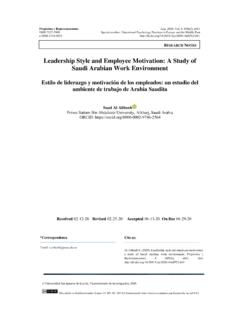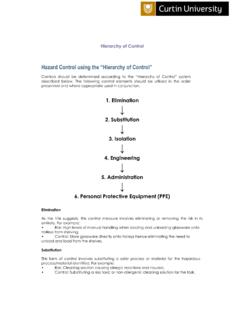Transcription of The Hydrogen Balmer Series and Rydberg Constant
1 The Hydrogen Balmer Series and Rydberg Constant by Dr. James E. Parks Department of Physics and Astronomy 401 Nielsen Physics Building The University of Tennessee Knoxville, Tennessee 37996-1200 Copyright March 2002 by James Edgar Parks* *All rights are reserved. No part of this publication may be reproduced or transmitted in any form or by any means, electronic or mechanical, including photocopy, recording, or any information storage or retrieval system, without permission in writing from the author. Objectives The objectives of this experiment are: (1) to study the emission of light from a Hydrogen discharge source, (2) to learn the empirical formulas to characterize the pattern of spectral lines from Hydrogen , (3) to learn the postulates for developing the Bohr model of the Hydrogen atom, (4) to study and develop the Bohr theory of the Hydrogen atom, (5) to measure the wavelengths of the Balmer Series of visible emission lines from Hydrogen , and (6) to learn to analyze the wavelength data to determine the Rydberg Constant using the Bohr model formulation.
2 Theory Hydrogen atoms in a discharge lamp emit a Series of lines in the visible part of the spectrum. This Series is called the Balmer Series after the Swiss teacher Johann Balmer (1825-1898) who, in 1885, found by trial and error a formula to describe the wavelengths of these lines. This formula is given by 221112Rn = (1) where n are integers, 3, 4, 5, .. up to infinity and R is a Constant now called the Rydberg Constant . In the SI system of units, R= x 107 m-1. Balmer suggested that his formula may be more general and could describe spectra from other elements.
3 Then in 1889, Johannes Robert Rydberg found several Series of spectra that would fit a more The Hydrogen Balmer Series general relationship, similar to Balmer s empirical formula. This general relationship is known as the Rydberg formula and is given by 22111- iffi,Rnnnn = > (2) where ni and nf are integers, 1, 2, 3, 4, 5, .. up to infinity, with ni>nf. For the Hydrogen atom, ni = 2 corresponds to the Balmer Series . There are other Series in the Hydrogen atom that have been measured. The Lyman Series is a set of ultraviolet lines that fit the relationship with ni = 1.
4 A Series in the infrared region of the spectrum is the Paschen Series that corresponds to ni = 3. The Brackett and Pfund Series are two more in the infrared region corresponding to ni = 4 and ni = 5. The individual lines in the Balmer Series are given the names Alpha, Beta, Gamma, and Delta, and each corresponds to a ni value of 3, 4, 5, and 6 respectively. Wavelengths of these lines are given in Table 1. Table 1. Balmer Series Some Wavelengths in the Visible Spectrum. Name of Line nfniSymbolWavelength Balmer Alpha 2 3 H nm Balmer Beta 2 4 H nm Balmer Gamma2 5 H Balmer Delta 2 6 H nm In 1913 the Danish physicist Niels Bohr was the first to postulate a theory describing the line spectra observed in light emanating from a Hydrogen discharge lamp.
5 With Albert Einstein s theory for the photoelectric effect, where a photon has energy proportional to its frequency, Bohr postulated the existence of energy levels in the atom. He assumed that the energy associated with the photons of light were the result of transitions in the atom from one level to another, with the energy of the photon being equal to the difference in the internal energies specific to energy levels involved in the transition from an initial state to a final state, so that (3) Energy of Photon = - [ Energy of Final State - Energy of Initial State ] or []fiifEEE EE = =.
6 (4) The negative signs in front of the brackets in Equations (3) and (4) are because the photons are being emitted instead of being absorbed. Also, the levels are bound states and are assigned negative values. In other words, the atom is giving up energy instead of having energy supplied to it. 2 The Hydrogen Balmer Series In 1905 Albert Einstein worked out the theory for the photoelectric effect using a concept that Max Planck had used to describe black body radiation. In this theory, for which Einstein received his Nobel prize, he postulated that light consists of packets of energy called photons or quanta and that each quantum of light has energy proportional to its frequency.
7 He determined that the energy of a photon, Ephoton is given by photonEh = (5) where is the frequency of the photon and h is a Constant of proportionality called Planck s Constant . Planck s Constant is equal to (40)x10-34 J s. From the electromagnetic wave theory of light, frequency and wavelength are related to the speed of light by c =, so that photoncEhh == (6) and ifchEE E= = (7) which relates the wavelength of the emitted light to the difference in energy levels between the final and initial states of the atom.
8 Bohr postulated that an electron can move about the nucleus of an atom in stable orbits, without emitting radiation and losing energy. Thus its energy would be Constant in any single orbit and its energy would change only if it changed orbits and a transition occurred by the electron moving from one stable orbit to another. This postulate was revolutionary in that it contradicted electromagnetic theory, which predicted that the accelerating electron would radiate energy. In order to have stable orbits, Bohr further postulated that the magnitude of the orbiting electron s angular momentum would be quantized and that it must be an integral multiple of the quantity h/2.
9 Since the angular momentum L for an electron of mass me moving in an orbit of radius r with a speed v is eLmvr=, (8) his postulate then yields n = 1, 2, 3, 2ennhmvrn =" (9) where vn is the speed of the electron and rn is its radius as it orbits with an integral number n of the quantity h/2 . The number n is referred to as the Principal Quantum Number. 3 The Hydrogen Balmer Series Except for the assumption that the angular momentum is quantized, Bohr s model for the Hydrogen atom was developed using simple classical concepts.
10 He assumed that the electron was small in mass compared to the single proton in the nucleus and that it moved about this proton in a circular orbit. He said that the electron was held in an orbit by the electrical force FE between the electron and proton, that is given by Coulomb s Law, 22014 EneFr = (10) where e is the magnitude of charges of the electron and proton, rn is the radius of the orbit, and 0 is a Constant known as the permittivity of free space. The electrical force is the force that supplies the centripetal force, FC, needed to keep the electron in orbit and is given by 2enCnmvFr= (11) where me is the mass of the electron and vn is the speed of the electron as moves in the circular orbit of radius rn.
